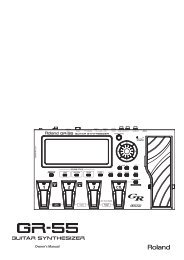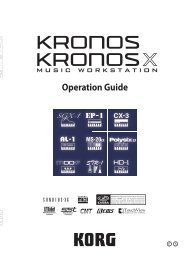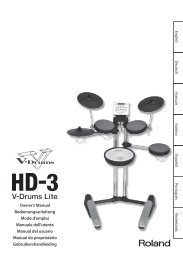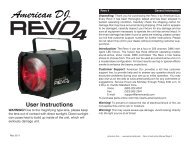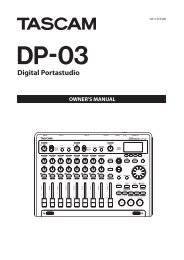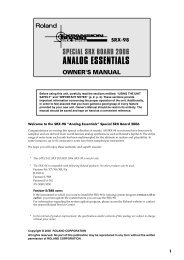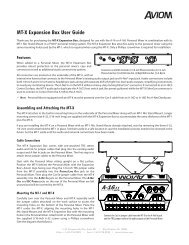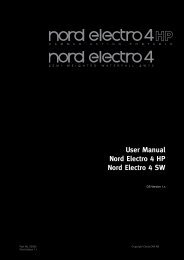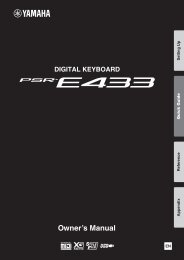Korg Microkorg Owner's Manual - zZounds.com
Korg Microkorg Owner's Manual - zZounds.com
Korg Microkorg Owner's Manual - zZounds.com
You also want an ePaper? Increase the reach of your titles
YUMPU automatically turns print PDFs into web optimized ePapers that Google loves.
3. OSC1 (Oscillator 1) — SYNTH/VOCODER<br />
The oscillator generates the waveform that is the basis of the sound.<br />
The timbre has two oscillators. The settings in this section are for oscillator 1. "WAVE" (knob 1) selects the basic waveform for oscillator 1,<br />
and "CONTROL 1" (knob 2) and "CONTROL 2" (knob 3) modify the waveform. For example if you set "WAVE" to Saw ( ), adjusting the<br />
"CONTROL 1" value will modify the sound, changing the waveform as shown in figure 3-1. Adjusting "CONTROL 2" will apply LFO1<br />
modulation to the waveform specified by "CONTROL 1," producing additional change.<br />
WAVE<br />
[Saw, Square, Triangle, Sine, Vox,<br />
DWGS, Noise, Audio In]<br />
Selects the waveform for oscillator 1.<br />
Saw Wave ( ):<br />
This is a sawtooth wave. This waveform<br />
is shaped like the tooth of a<br />
saw, and contains a rich overtone<br />
spectrum.<br />
You can use this to create numerous<br />
instrumental sounds such as<br />
string and brass sounds, or typical<br />
analog synth sounds such as synth<br />
bass or synth brass.<br />
CONTROL 1 [0...127/– – –]<br />
Adjusts a parameter specific to the<br />
selected waveform.<br />
CONTROL 1 has no effect if<br />
"WAVE" is set to DWGS.<br />
CONTROL 1 [0...127]:<br />
Adjusting this value will modify the<br />
waveform.<br />
A setting of 0 will produce a conventional<br />
sawtooth wave, and a setting<br />
of 127 will produce a sawtooth<br />
wave one octave higher.<br />
(➝Figure 3-1)<br />
CONTROL 2 [0...127/1...64]<br />
Adjusts a parameter specific to the<br />
selected waveform.<br />
CONTROL 2 [0...127]:<br />
LFO1 is used to apply modulation<br />
to the waveform specified by<br />
"CONTROL 1." The "CONTROL 2"<br />
setting specifies the depth of the<br />
modulation produced by LFO1.<br />
For example by setting LFO1<br />
"WAVE" to Triangle ( ) and adjusting<br />
the LFO speed, you can produce<br />
a detune-like effect.<br />
Figure 3-1<br />
0 63 127<br />
18<br />
Square Wave ( ):<br />
This is a square wave. It has a rectangular<br />
shape, and strictly speaking is<br />
actually square only when the top and<br />
bottom of the waveform have the same<br />
width (a "pulse width" of 50%). If the<br />
pulse width is other than 50%, this is<br />
also called a pulse wave.<br />
A square wave is used for woodwind<br />
sounds such as clarinet, and for<br />
wooden percussion sounds. A pulse<br />
wave is used for plucked-string<br />
sounds and reed-type sounds.<br />
CONTROL 1 [0...127]:<br />
Adjusts the pulse width. A setting<br />
of 0 produces a pulse width of 50%<br />
(square wave), and a setting of 127<br />
produces a pulse width of 0% (there<br />
will be no sound). The sound will<br />
be<strong>com</strong>e "harder" as you adjust this<br />
parameter toward 0%.<br />
(➝Figure 3-2)<br />
CONTROL 2 [0...127]:<br />
LFO1 is used to apply PWM (pulse<br />
width modulation)* 3-1 to the pulse<br />
width specified by "CONTROL 1."<br />
The "CONTROL 2" setting specifies<br />
the depth of the modulation produced<br />
by LFO1. For example by<br />
setting LFO1 "WAVE" to Triangle<br />
( ) and adjusting the LFO<br />
speed, you can add depth to the<br />
sound.<br />
Figure 3-2<br />
0 63 127<br />
*3-1: PWM<br />
Pulse Width Modulation refers to the<br />
use of a separate signal to vary the<br />
pulse width over time. On the<br />
microKORG, you can use PWM to<br />
modify the tone via LFO1, or via Virtual<br />
Patch from modulation sources<br />
LFO2, Filter EG, or Amp EG.



